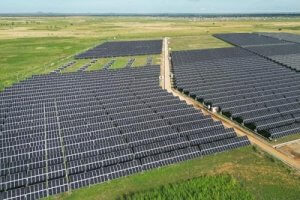Cameroon is finally launching its long-awaited solar power plant project in the northern regions. Announced in 2021, the initiative will be effective this month. An official release from the Department of Water and Energy revealed that Minister Gaston Eloundou Essomba will preside over the launch ceremony during his visit to the site from September 19 to 23.
With a combined capacity of 30 MW, the infrastructures have been built in the towns of Guider, in the North region, and Maroua, the regional capital of the Far North. “The official commissioning of these two solar power plants will substantially improve the quality of the public electricity service in the northern part of the country, which was previously subject to drastic drops in production from the Lagdo dam. With the introduction of these solar power plants, the need for costly thermal power plants to supplement electricity production will diminish, resulting in budget savings for the state,” says Minister Gaston Eloundou Essomba in the above-mentioned press release.

Although they will be inaugurated and officially commissioned in September 2023, the Maroua and Guider solar power plants, which have been gradually injecting their megawatts into the Northern Interconnected Network (RIN) since the end of 2022, have already helped to improve electricity supply in the northern part of Cameroon. According to power utility Eneo, in Q1 2023, for example, the regions of Nord, Adamaoua, and Extrême-Nord, which make up the RIN, did not experience the usual load shedding due to production shortfalls. This is a significant milestone, considering that the two solar plants had been injecting only between 15 and 18 MW into the grid during this period for the past three years.
Let’s recall that the project was in the pipeline since 2021 but it was this year that the government finally approved Scatec’s bid. This Norwegian company proposed to address the drastic drop in the water level of the Lagdo dam by constructing photovoltaic power plants with a capacity of 30 MW. The Lagdo dam’s production had dropped to only 20 MW from an installed capacity of 72 MW.
However, due to technical constraints, the project could not start in 2021 as initially planned by the government. “It’s an interesting project. But we have to be cautious for two reasons. First, it’s a new technique in Cameroon, and solar energy is somewhat unique. Even though there is plenty of sunlight in the North, solar energy is by definition variable. We need to ensure that the amount of energy injected from these modular power plants will be stable, as demanded by both industrial and residential customers. So, there are technical aspects that need to be verified. Second, faced with this spontaneous offer, we are still obliged to conduct consultations to ensure there are no alternative offers,” a source close to the matter told Business in Cameroon in May 2021.
The delay in implementing this project forced the Cameroonian government and Eneo in 2021 to transfer 20 MW of thermal power from the Ahala power plant (near Yaoundé) to Garoua (12 MW in Djamboutou) and Ngaoundéré (8 MW) to alleviate daily power outages for the populations and businesses in the northern region. This transfer of capacities generated unsustainable additional fuel costs, then estimated at around CFA2.4 billion per month (CFA80 million per day), as revealed by internal sources at Eneo.
According to estimates from the Ministry of Water and Energy, leasing Scatec’s modular solar power plants for four years should result in gains of about CFA5 billion in the first nine months of operation due to the shutdown of certain thermal power plants in this part of Cameroon.